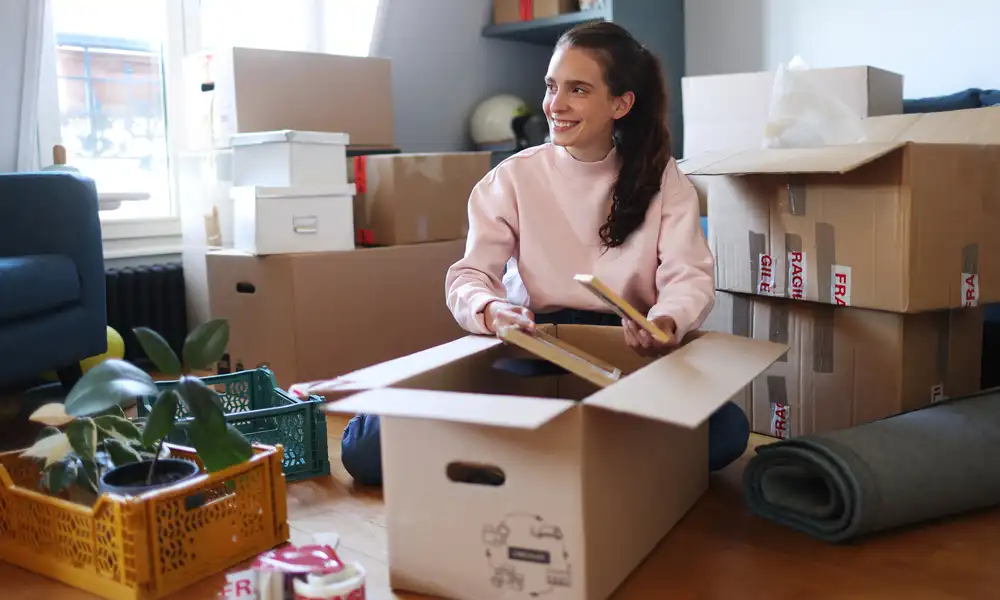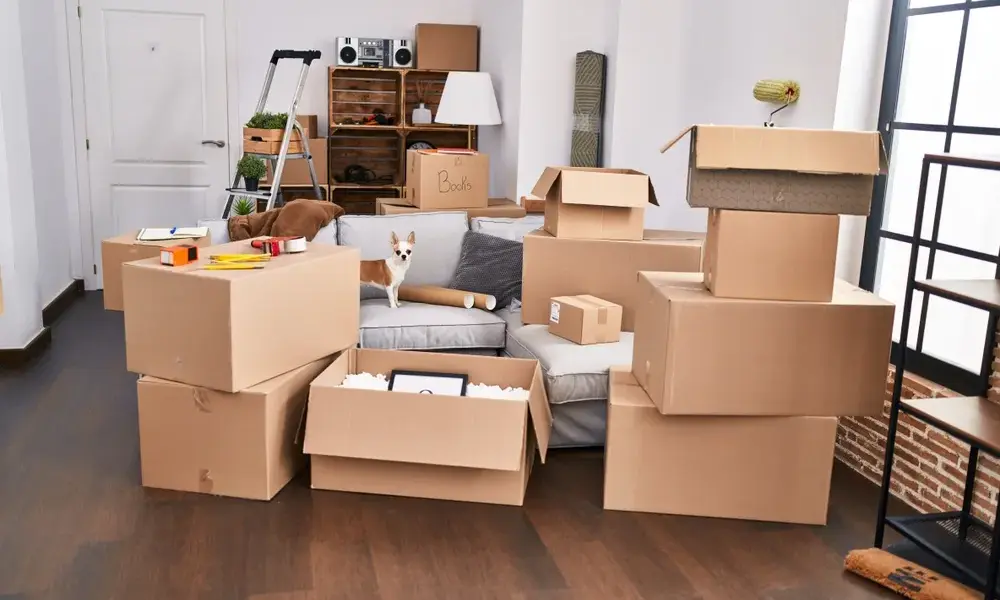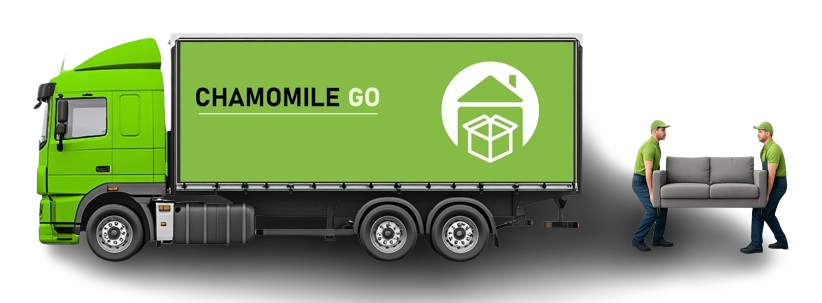How many moving boxes do I need is one of the first questions people ask when planning a move. Estimating the right number of packing boxes for move is important because it helps you stay organized, save money, and avoid last-minute stress. Buying too few boxes can leave you scrambling on moving day, while buying too many wastes space and budget. A simple moving box calculator can give you an estimate, but it’s also useful to understand the different types of moving boxes and sizes and how many are recommended based on the size of your home. This way, you can plan ahead and make your move smoother and more efficient.
Why Estimating Moving Boxes Matters

When planning a move, many people focus on movers, trucks, or packing supplies but forget one simple thing the number of boxes needed. A proper moving box estimate can save you money, reduce stress, and keep your belongings safe. Let’s break down why estimating moving boxes matters and how a moving boxes checklist can help.
1. Cost Efficiency: Avoid Buying Too Many or Too Few
Purchasing boxes without a plan is one of the most common blunders individuals make. If you buy too many, you waste money and space. If you buy too few, you’ll end up making extra trips to the store during the packing process.
A moving box estimate helps you balance costs. For example:
- A studio apartment might need 15–20 boxes.
- A 2-bedroom home may need 40–60 boxes.
- A larger house could require 80+ boxes.
Using a moving boxes checklist ensures you get the right number without overspending.
2. Better Organization and a Smoother Packing Process
Having the correct amount of boxes isn’t just about cost — it’s about organization. When you estimate properly, you can assign boxes for each room and label them clearly. This makes unpacking faster and stress-free.
A moving boxes checklist also helps you track what items go into which box. For example:
- Small boxes for books and fragile items.
- Medium boxes for kitchenware.
- Large boxes for bedding and clothes.
This structure keeps everything organized from start to finish.
3. Preventing Damage with the Right Box Type
Not all boxes are created equal. Your possessions may sustain damage if you utilize the incorrect kind. Heavy items packed in oversized boxes may collapse. Fragile items packed without padding may break.
By using a moving box estimate, you’ll know exactly how many of each type you need:
- Dish pack boxes for kitchenware.
- Wardrobe boxes for clothing.
- Heavy-duty boxes for electronics or books.
Pairing the estimate with a moving boxes checklist ensures your belongings are protected during transit.
You may read How To Make Moving Less Stressful?
Types of Moving Boxes and Sizes
Choosing the right box is just as important as estimating how many you need. Each box type has a specific purpose, and using the right one keeps your belongings safe and your move organized. We’ll go over the most popular sizes and types of moving boxes, their measurements, and their ideal applications below.
Small Moving Boxes (1.5 cu ft)
Dimensions: about 16″ x 12″ x 12″
Best For:
- Books
- Canned goods
- Hand tools
- Small, heavy items
These boxes are made to hold weighty but small items. A moving boxes checklist should always include several of these for safe lifting and packing efficiency.
Medium Moving Boxes (3 cu ft)
Dimensions: about 18″ x 18″ x 16″
Best For:
- Kitchenware
- Clothing
- Small appliances
- Toys
This is the most versatile size in any moving box estimate. Medium boxes are easy to carry and fit most household items.
Large Moving Boxes (4.5 cu ft)
Dimensions: about 18″ x 18″ x 24″
Best For:
- Bedding
- Towels
- Bulkier but lighter items
Large boxes are great for bigger belongings that aren’t too heavy. Avoid overloading them with books or tools, as they can tear under weight.
Extra-Large Moving Boxes (6 cu ft)
Dimensions: about 24″ x 18″ x 24″
Best For:
- Linens
- Pillows
- Comforters
- Lightweight but bulky items
These oversized boxes are perfect for cushioning soft goods. Always include a few in your moving boxes checklist for bedding and seasonal storage.
Specialty Moving Boxes
Sometimes, standard sizes aren’t enough. Specialty boxes protect specific belongings that need extra care.
Common Types:
- Wardrobe Boxes: Tall boxes with a metal bar for hanging clothes.
- Dish Packs: Double-walled boxes designed for fragile kitchenware.
- TV Boxes: Flat, heavy-duty boxes for screens and electronics.
- File Boxes: Strong boxes for documents and office supplies.
Including specialty boxes in your moving box estimate ensures fragile or valuable items arrive safely.
If you’re looking for moving services in Sherman Oaks, Chamomile Go is here to make your relocation easy and stress-free. Our team provides professional local and long-distance solutions tailored to your needs. From careful packing and loading to safe transportation, we handle every detail with expertise. Contact Chamomile Go today and experience reliable moving services in Sherman Oaks.
How Many Moving Boxes Do You Need Exactly?

One of the most common questions people ask before relocating is: “How many boxes will I need?” The answer isn’t one-size-fits-all. The number of boxes depends on your home size, lifestyle, family members, and even hidden storage areas you might forget about. Let’s break it down step by step.
Factors That Decide the Number of Moving Boxes
1. Size of Your Home
- Studio or 1-Bedroom Apartment: Usually 15–25 boxes.
- 2-Bedroom Apartment/Small Home: Around 30–40 boxes.
- 3–4 Bedroom House: 50–80 boxes.
- Large Homes (5+ Bedrooms): 90+ boxes.
Larger spaces naturally hold more belongings, so the box count rises as square footage increases.
2. Lifestyle Habits
- Minimalist: If you live with only essentials, you’ll need fewer boxes than average.
- Collector or Shopper: If you love clothes, books, or home décor, expect your box count to increase by 20–30%.
3. Number of Family Members
Every person adds extra clothing, toys, personal items, and daily necessities. For example, a couple might need 40–50 boxes, while a family of four could require 70–90.
4. Storage Spaces Often Forgotten
Garages, attics, and basements are box-eaters. Many people underestimate how much they’ve stored in these spaces. Always add an extra 10–15 boxes if you have a full garage, basement, or attic.
Quick Tips to Estimate Boxes Smartly
- Start with the average for your home size.
- Add more if you have a big family or lots of storage spaces.
- Keep 5–10 extra boxes handy almost everyone underestimates in the beginning.
- Use a mix of small, medium, and large boxes for balance. Heavy items like books go in smaller boxes, while lighter items like pillows go in large ones.
Number of Recommended Moving Boxes Based on Home Area
When planning your move, it helps to have a rough estimate of how many boxes you’ll actually need. The table below gives a simple breakdown by home size and the type of boxes usually required.
| Home Size / Area | Estimated Number of Boxes | Breakdown (Small, Medium, Large, Specialty) |
| Studio Apartment | 15–20 | Mostly small & medium for essentials and clothes |
| 1-Bedroom Home | 20–30 | Mix of medium & large for kitchen and living room items |
| 2-Bedroom Home | 40–50 | Balanced variety across small, medium, large |
| 3-Bedroom Home | 60–80 | Includes specialty boxes for fragile items |
| 4-Bedroom+ Home | 90–120+ | High volume of all sizes plus specialty for storage or delicate items |
Key Takeaways from the Table
- Smaller spaces need fewer boxes, but they still require a smart mix of sizes.
- Larger homes call for more specialty options, especially for fragile or bulky belongings.
- Always plan for 5–10 extra boxes beyond the estimate you’ll almost always discover last-minute items.
Final Thoughts
The number of boxes you’ll need always comes down to your home size, lifestyle, and storage habits. A smaller space might only require a few dozen, while larger homes often need much more. Planning ahead and keeping extra boxes on hand will save you from stress on moving day. Staying prepared means smoother packing, safer belongings, and less last-minute chaos. If you’d like expert guidance and hands-on help, our team is here for you. Reach out to Chamomile Go today and make your next move effortless.
FAQs
1. Does The Size Of My Home Decide The Number Of Boxes?
Yes. A studio may need around 15–20, while a 3-bedroom house could require 60–80. The bigger the space, the more belongings you’ll likely have to pack.
2. Do Storage Areas Like Garages And Attics Affect The Count?
Absolutely. Many people forget about items stored in garages, basements, or attics. These areas can add 10–15 extra boxes to your estimate.
3. What If I Live A Minimalist Lifestyle?
If you only keep essentials, you’ll need fewer boxes than average. Collectors or families with kids often require 20–30% more than the typical estimate.
4. Should I Buy Extra Boxes Just In Case?
Yes. Keeping 5–10 extra boxes is always smart. It’s better to have a few leftovers than run out in the middle of packing.
5. Can Professional Movers Help Me Figure Out The Right Number?
Definitely. Movers can assess your home, belongings, and storage spaces to recommend the right amount. This ensures you don’t overbuy or fall short.







